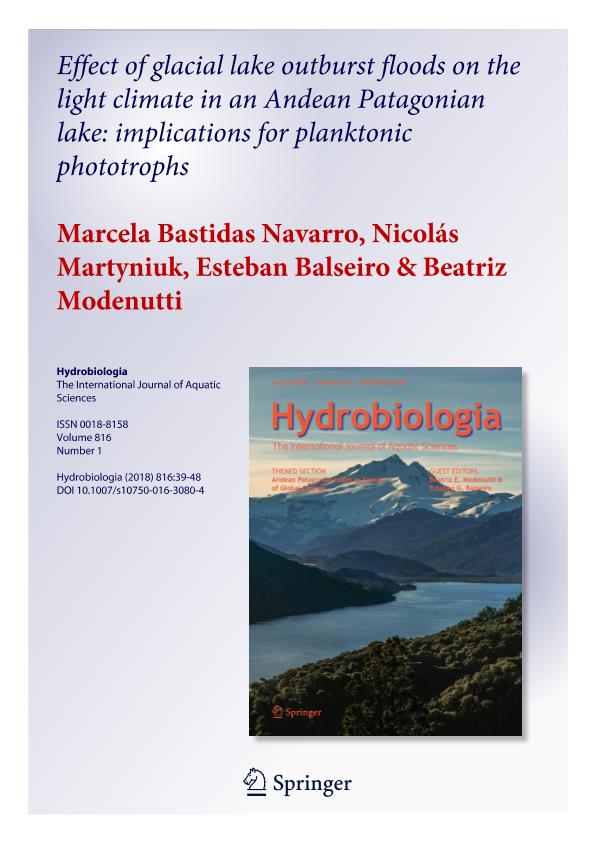Artículo
Effect of glacial lake outburst floods on the light climate in an Andean Patagonian lake: implications for planktonic phototrophs
Bastidas Navarro, Marcela Alejandra ; Martyniuk, Nicolás Alejandro
; Martyniuk, Nicolás Alejandro ; Balseiro, Esteban Gabriel
; Balseiro, Esteban Gabriel ; Modenutti, Beatriz Estela
; Modenutti, Beatriz Estela
 ; Martyniuk, Nicolás Alejandro
; Martyniuk, Nicolás Alejandro ; Balseiro, Esteban Gabriel
; Balseiro, Esteban Gabriel ; Modenutti, Beatriz Estela
; Modenutti, Beatriz Estela
Fecha de publicación:
07/2018
Editorial:
Springer
Revista:
Hydrobiologia
ISSN:
0018-8158
e-ISSN:
1573-5117
Idioma:
Inglés
Tipo de recurso:
Artículo publicado
Clasificación temática:
Resumen
Climate change is altering temperature and precipitation patterns all over the world. In North Patagonia, glaciers of the Tronador mountain (41°S) show a continuous and maintained recession, and these meltwaters are transported to Lake Mascardi via the Upper Manso River that carries a large amount of glacial clay. These suspended sediment particles cause a very sharp light longitudinal gradient along the western branch of Lake Mascardi (Tronador arm). Here we analysed changes in the water transparency along the gradient, in particular before and after a glacial lake outburst flood (GLOF) event that occurred in the headwaters that feed Lake Mascardi. The GLOF caused a significant decrease in turbidity over the years following the event. The depth of the deep chlorophyll maxima (DCM) was directly related to the light penetration, and the decrease in suspended solids load deepened the DCM in the years after the GLOF event. Among photosynthetic organisms, picocyanobacteria and total nanoflagellates abundances increased after the GLOF event when transparency increased due to the decrease in the clay and sediment inputs into the lake. Our data demonstrated that the DCM and phytoplankton are useful variables to predict changes in the lake light climate.
Archivos asociados
Licencia
Identificadores
Colecciones
Articulos(INIBIOMA)
Articulos de INST. DE INVEST.EN BIODIVERSIDAD Y MEDIOAMBIENTE
Articulos de INST. DE INVEST.EN BIODIVERSIDAD Y MEDIOAMBIENTE
Citación
Bastidas Navarro, Marcela Alejandra; Martyniuk, Nicolás Alejandro; Balseiro, Esteban Gabriel; Modenutti, Beatriz Estela; Effect of glacial lake outburst floods on the light climate in an Andean Patagonian lake: implications for planktonic phototrophs; Springer; Hydrobiologia; 816; 1; 7-2018; 39-48
Compartir
Altmétricas



